Doberman tattoos walk a great line: equal parts elegant and intense, sleek yet expressive. Below you’ll find 28 distinct design ideas based on the images you shared—each one broken down like a magazine feature so you can visualize linework, shading, placement, and the vibe it broadcasts.
Geometric Fine Line Doberman
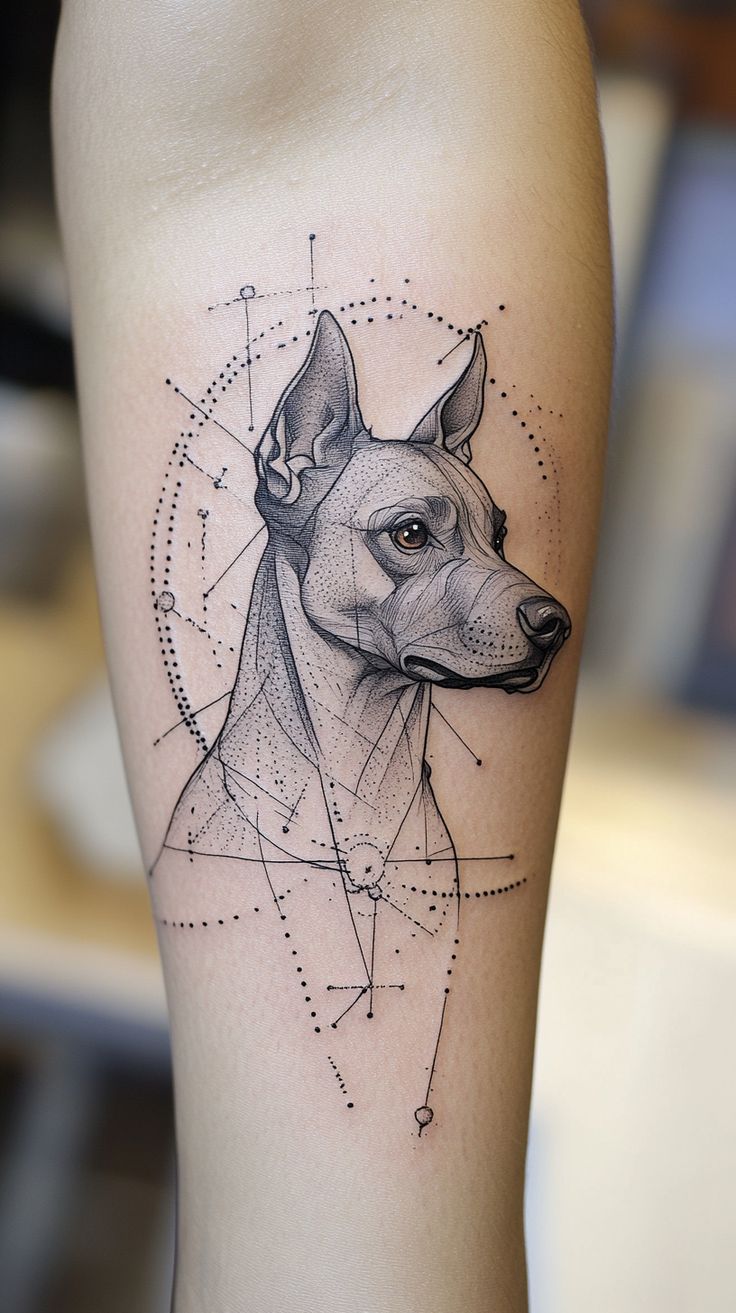
This piece blends a realistic Doberman portrait with a fine-line constellation of dots, arcs, and measuring marks, almost like a technical drawing overlaid with celestial cartography. The dog’s alert ears and steady gaze are rendered with delicate cross-hatching; around it, crisp outline work and pin-dot details orbit the head and chest. It reads as minimalist from afar, but up close the micro-textures give serious depth.
Why it works:
- The contrast between organic fur shading and architectural guides gives the tattoo a cerebral, modern feel—perfect for someone who likes design with intention.
- On a man’s or woman’s arm, those dotted arcs echo the forearm’s curve and elongate the silhouette.
Styling tips & aftercare ideas:
- Ask your artist to prep a stencil that locks in the geometric spacing. Small dot clusters can soften over time, so plan a tidy touch-up window.
- Keep surrounding skin uncluttered if you want the orbital dots to read clean; if you’re building a sleeve, use similar micro-dot flares to connect future pieces.
Smiling Dotwork Portrait
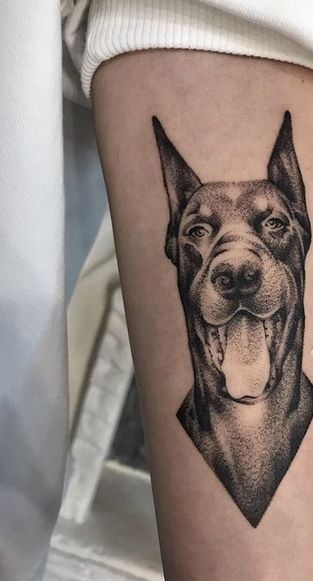
Here the Doberman’s head is modeled entirely with dotwork—thousands of stippled points forming planes of light across the muzzle and brow. The triangular chest ends in a tidy point, making the piece feel like a modern flashcardelevated to gallery quality. The ears are upright, the mouth is open, and the expression is friendly rather than angry.
Why it works:
- Dot density creates soft, photo-like transitions without heavy lines.
- The tapered base makes it easy to anchor on the inner forearm, where it sits naturally between wrist and elbow.
Styling tips:
- Avoid sun exposure during healing; dotwork can blur if overexposed.
- If you plan a companion piece, mirror the taper on the opposite arm for balance.
Botanical Realism with Red Sun
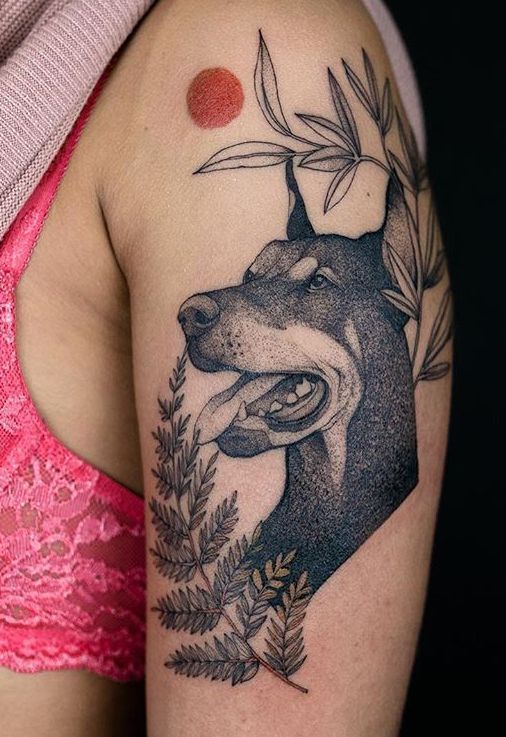
A regal head-and-neck portrait framed with ferns and olive-like sprigs, capped by a small vermillion circle that reads as a rising sun. The muzzle is slightly open—more panting than barking—giving the piece a candid, lifelike moment. The foliage adds motion, while the round sun acts as a visual period.
Why it works:
- Nature elements soften a realistic Doberman without sacrificing strength.
- The shoulder/upper-arm placement gives room for leaf silhouettes to arc around the deltoid.
Styling tips:
- Ask for a subdued green palette or grayscale leaves if you want the warm sun to remain the focal point.
- This pairs beautifully with a forearm realism piece—a rose, laurel, or favorite plant—to create a botanical thread.
Knife-Bite Blackwork with Spiked Collar
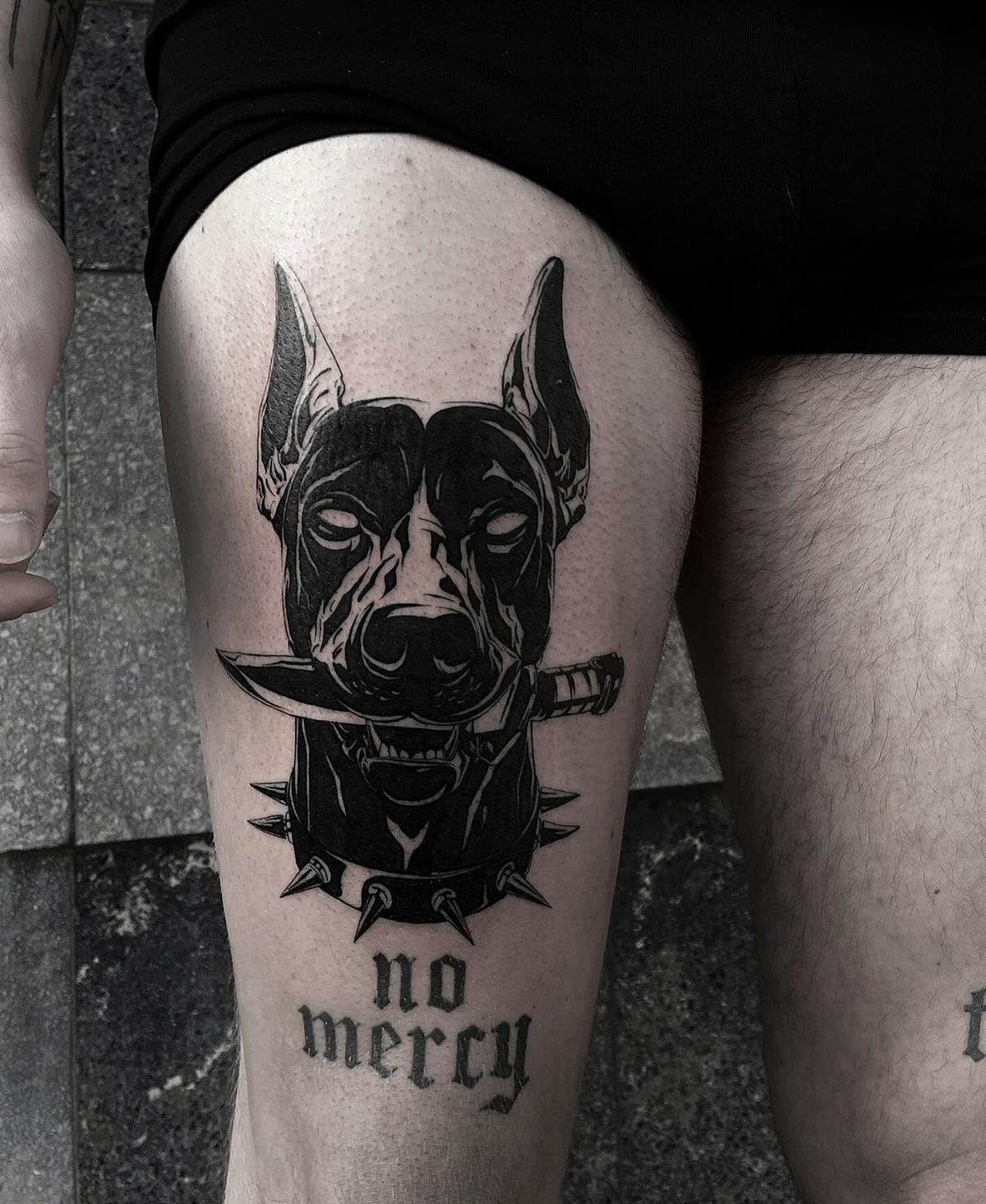
This is unapologetic blackwork: a high-contrast Doberman head, eyes ghosted out for menace, biting a knife above a spiked collar. Heavy fills and razor-sharp highlights give the fur a lacquered sheen. The bold wordmark underneath drives home an angry, no-nonsense statement. While it nods to trad/American traditional attitude, the execution is more neo-traditional with solid blacks and graphic silhouettes.
Why it works:
- Big blocks of ink age predictably and look strong from a distance—ideal for the thigh, where you can go large.
- A great pick for people who want a protective-spirit emblem rather than a portrait.
Styling tips:
- Keep negative space intentional—white highlights inside the ears and along the muzzle prevent a black mass.
- If you’re collecting flash, ask your artist to show knife and collar variants to swap in later.
Monochrome Rose & Portrait
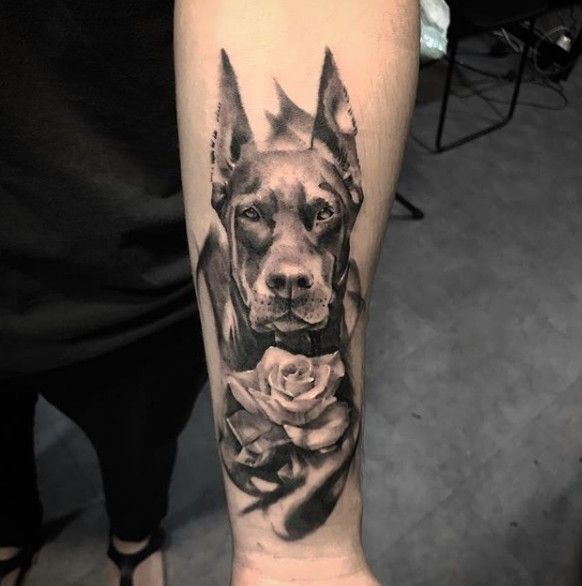
A realism banger: a soft black-and-gray portrait stacked over a fully modeled rose. The Doberman looks calm, eyes focused straight ahead; the rose petals coil into the negative space of the inner forearm, naturally framing the anatomy. Subtle smoke-like fades connect head to flower without hard borders.
Why it works:
- Integrating portraiture with flowers creates a personal and classic feel; roses may stand for devotion or a particular memory.
- The vertical setup flatters most arms and slips beautifully under a cuff.
Styling advice:
- For depth and ‘heaviness,’ request a mid-tone palette; too light and you’ll lose the definition of the cheeks.
- For lasting crispness, avoid stacking new pieces too closely to the rose edges. They need some room to breathe.
Color Portrait with Berries & Leaves
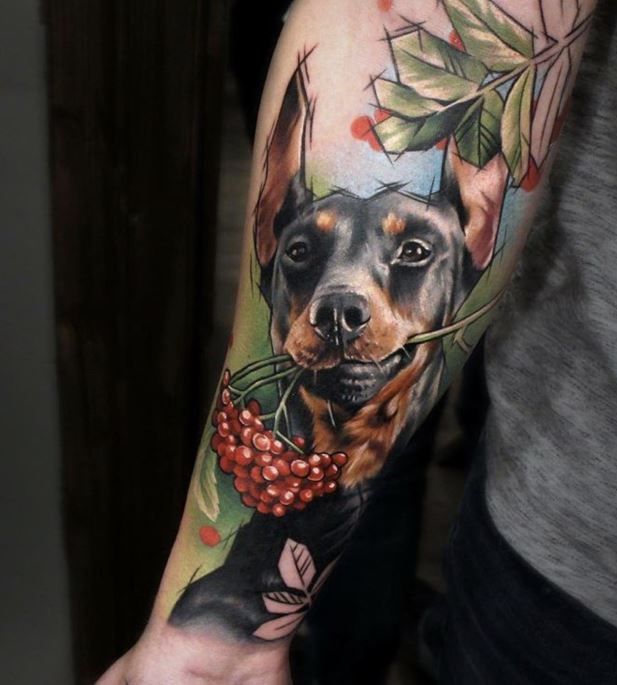
Bright, painterly depiction of a Doberman with clusters of red berries placed at the mouth and wrapped with leafy greens. The background is comprised of soft olive and teal, which makes the Doberman’s rust points stand out. It is the opposite of intimidating; the depiction is charming and a little bit mischievous while also being very wearable.
Why it works:
- The use of strategic color blocking, which is a contemporary realism technique, draws attention to the muzzle and eyes.
- The outline is restrained; color carries the form and keeps it lively instead of heavy.
Styling advice:
- If you’re color-curious but cautious, ask for desaturated greens and one saturated accent (the berries) so the piece feels adult.
- Great gateway tattoo for men who usually prefer grayscale but want a standout design.
Classic Color Realism on Upper Arm
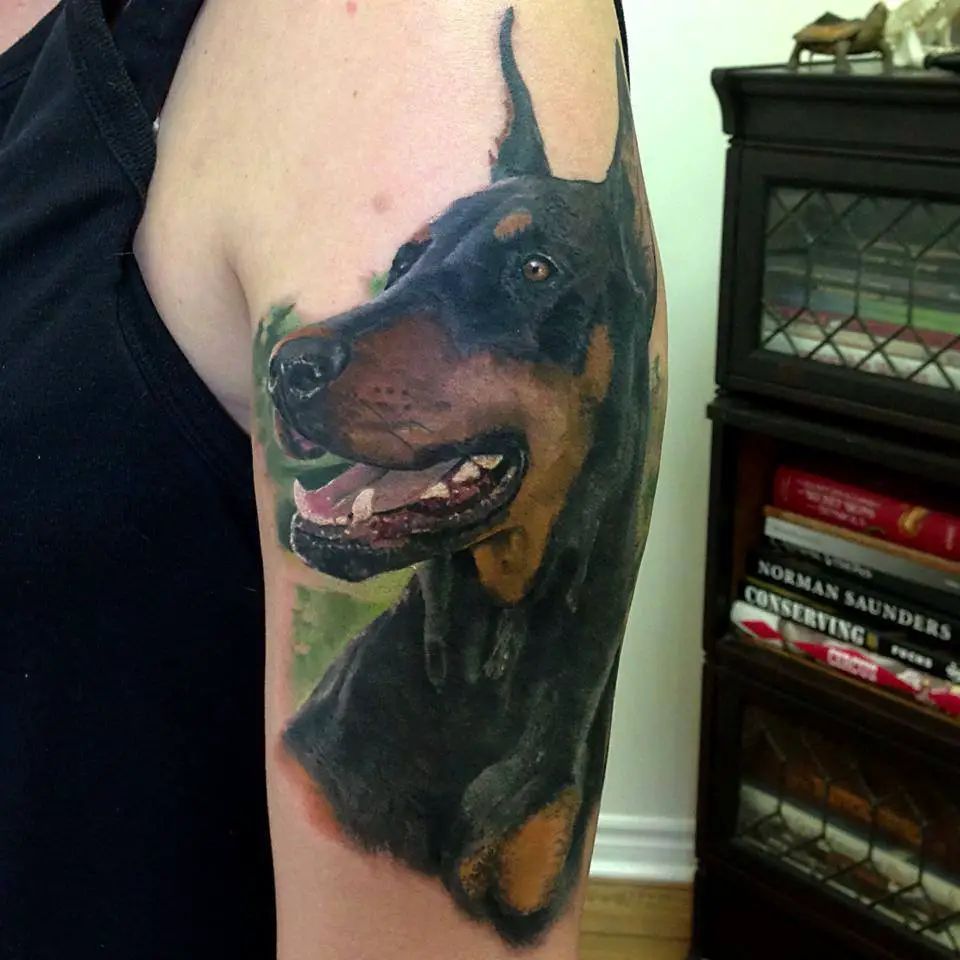
A textbook realistic head study with nuanced tan points and a glossy black coat. The Doberman looks off-axis, mouth slightly open, and ears cropped and proud. The background is a blurred, painterly green, echoing studio portraiture and placing all the attention on the dog’s expression.
Why it works:
- It’s the kind of realism that ages well when done with strong mid-tone transitions and confident highlights on the nose and eyes.
- The shoulder cap placement lets you go as minimalist or expansive as you like—easy to extend into a half-sleeve later.
Styling tips:
- Ask your artist to show the stencil and a quick value study first; great portraitists (the ones Tattoodo features often) will happily walk you through that prep.
- Consider a matching nameplate or birth flower beneath if the piece memorializes a pet.
Painterly Blackwork with Ink Splashes
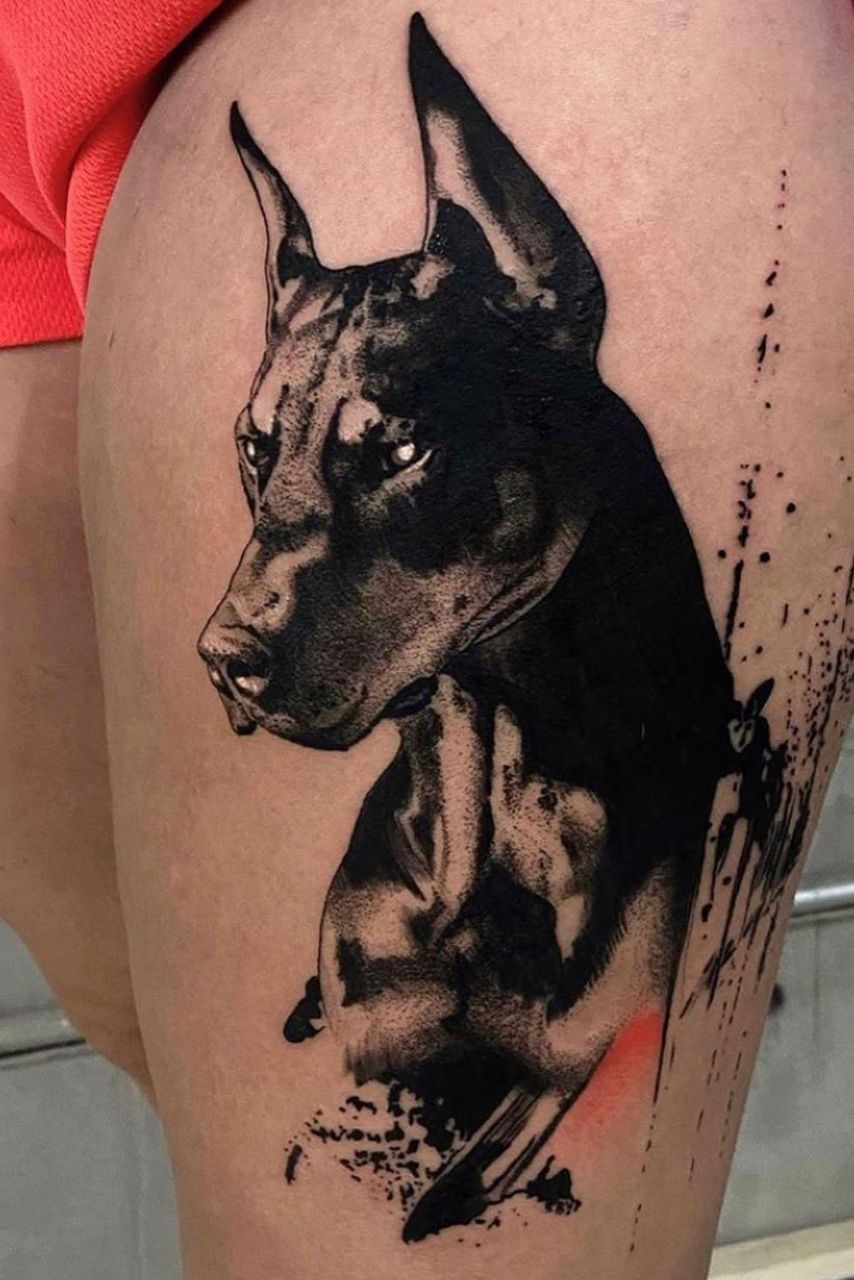
A moody, gallery-ready blend of blackwork and soft tonal realism. Dense blacks carve the ear and neck silhouettes, while laminated grays model the face. Ink spatters and dry-brush textures trail toward the hamstring, giving the piece a kinetic, “caught-in-motion” vibe.
Why it works: you get the authority of black filled with the nuance of portrait shading—commanding from a distance, intricate up close.
Styling tip: this reads best oversized on the thigh; ask for breathable negative space around the splashes so they don’t muddy over years.
Big-Scale Shoulder Portrait with Chain Collar
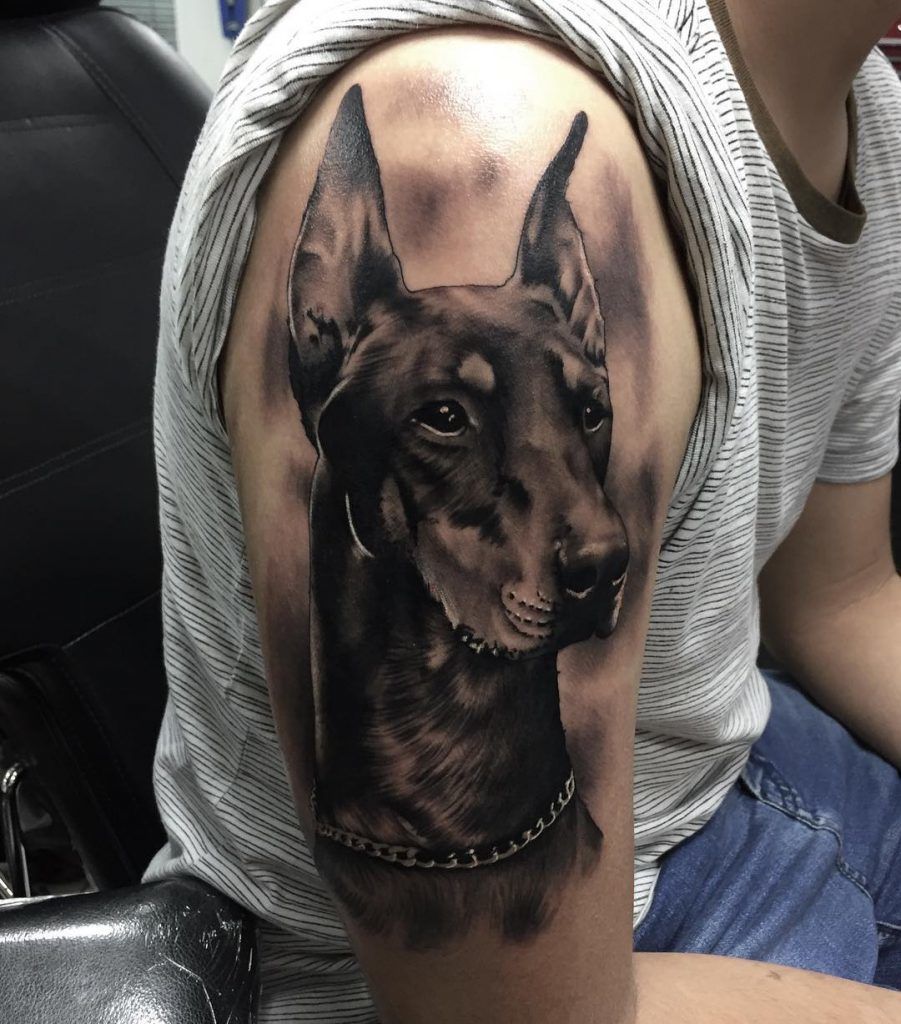
A large realism portrait anchored by a subtle chain. Gentle light rolls across the forehead and cheek, while a soft halo in the background separates ears from skin tone. It’s dignified—guardian energy without posturing.
Accessory suggestion: ask for a softer edge around the background to soften the dark ear tips; that gradation is a proven longevity technique in doberman tattoos
Minimalist Outline on Ankle
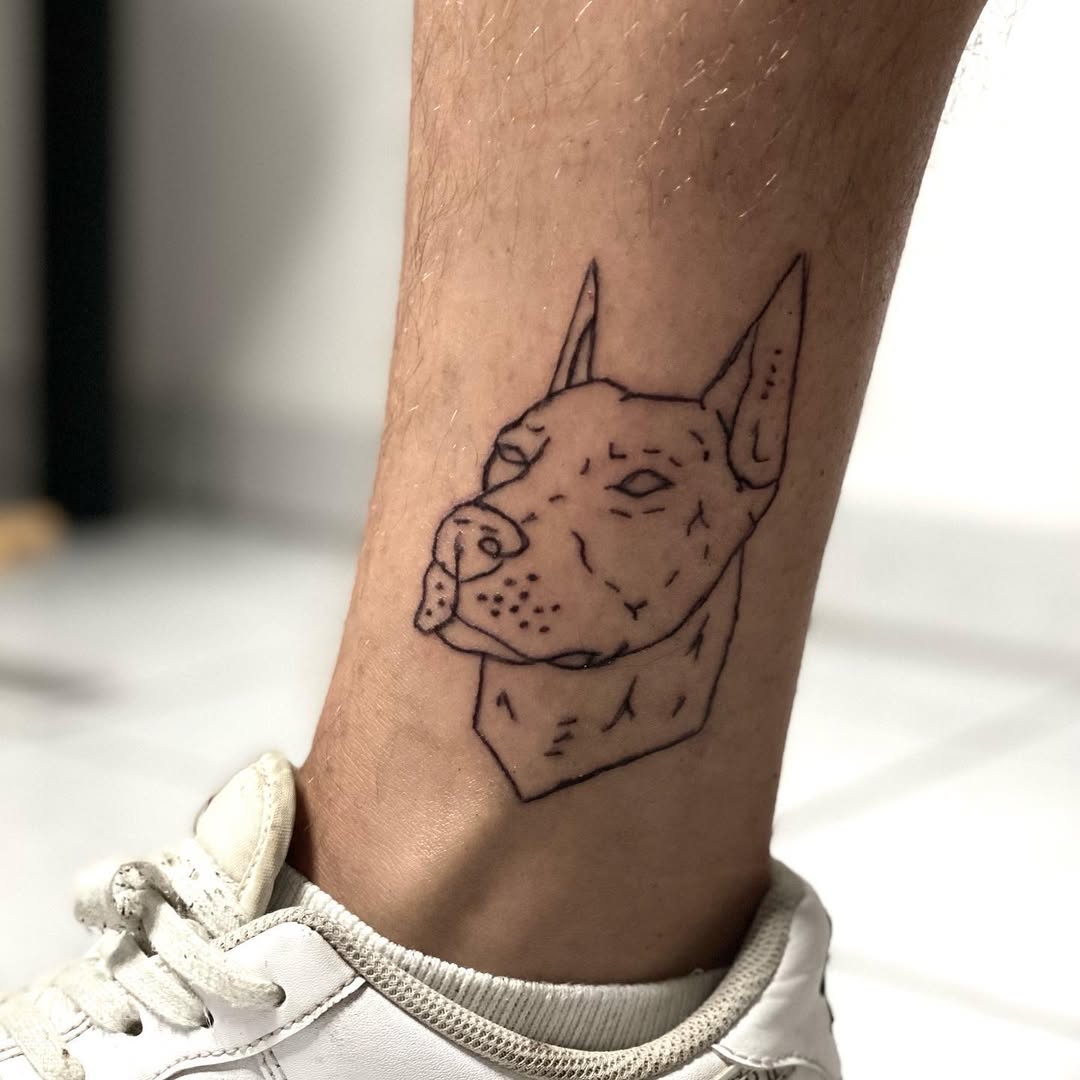
A clean, sketch-style outline with light dot clusters for whiskers and muzzle texture. No fills, no shading—just confident lines.
Why it works: this kind of minimalist mark works well with sneakers and cropped trousers; the slim jawline and sharp ears are graphic from afar.
Styling tip: Ultra-thin needles look chic but can fade fast near shoes—book a 12-month check-in for a tidy refresh.
Barking Trad Head with Spiked Collar
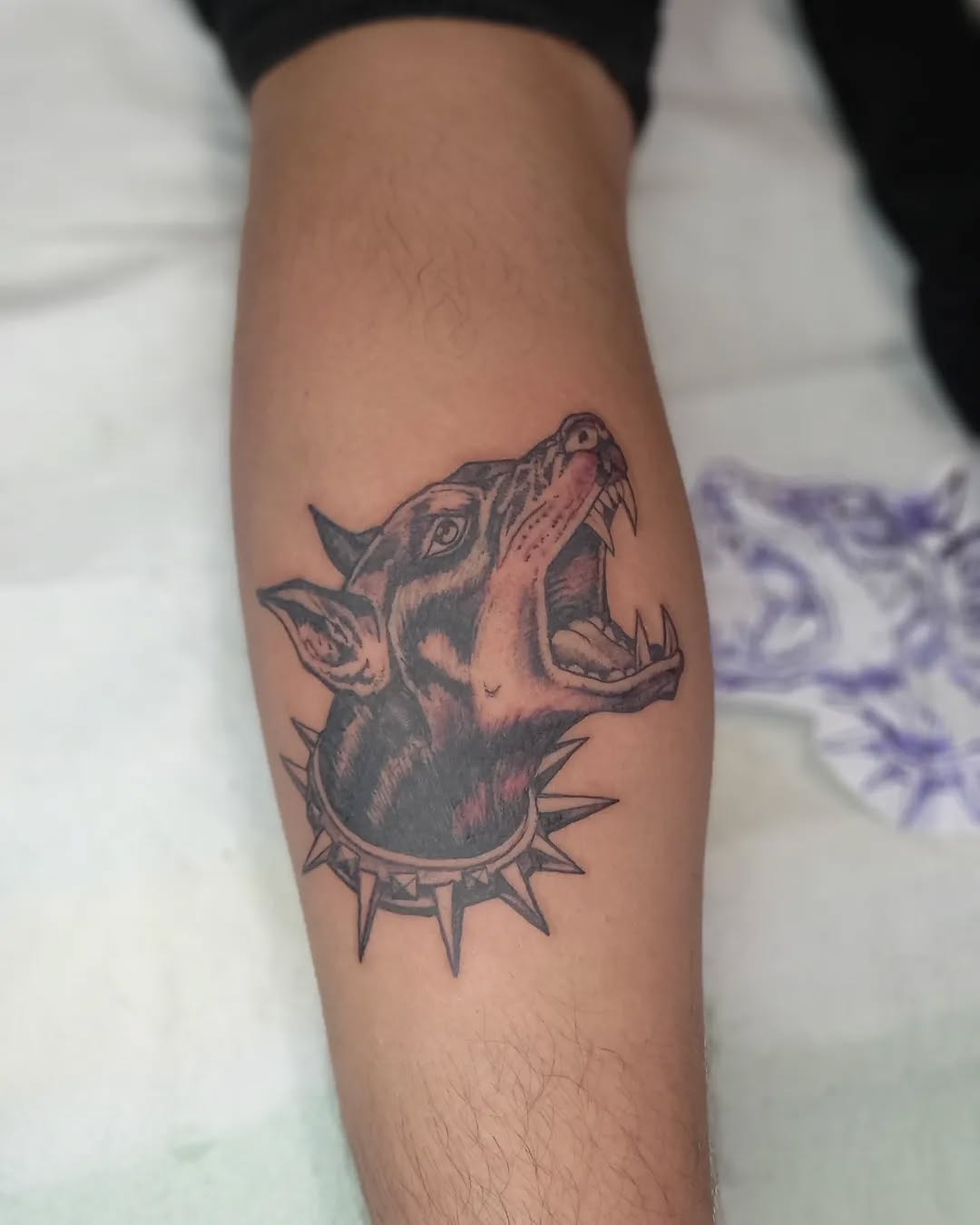
A snarling, open-mouthed head—a classic barking pose—rimmed with a spiked collar. Saturated blacks lock down the silhouette, while brick-red mid-tones add bite. It carries that American traditional/trad edge: bold lines, readable shapes, and no fear of attitude.
Styling tip: keep the teeth crisp negative space; they’ll stay bright even after the blacks settle.
Micro-Realism Cameo on Triceps
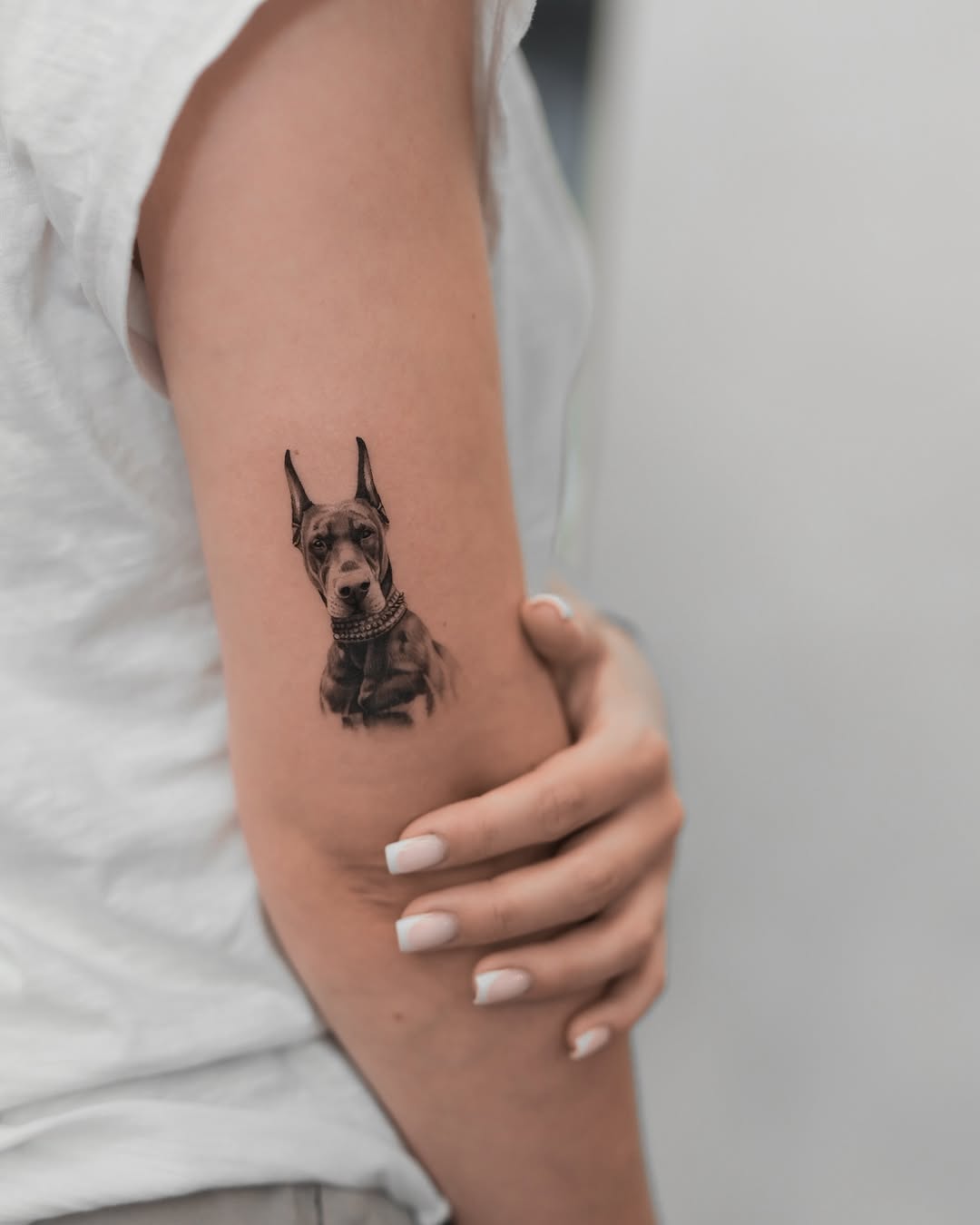
A tiny, pearl-sized portrait perched just above the elbow crease. Micro realism relies on pinpoint highlights—the catchlights in the eyes and the collar’s studs—to sell detail at scale.
Styling tip: avoid overworking tiny pieces; two to three passes for texture are enough. Overworking makes minis blur early.
Knife-Carry Mini Portrait
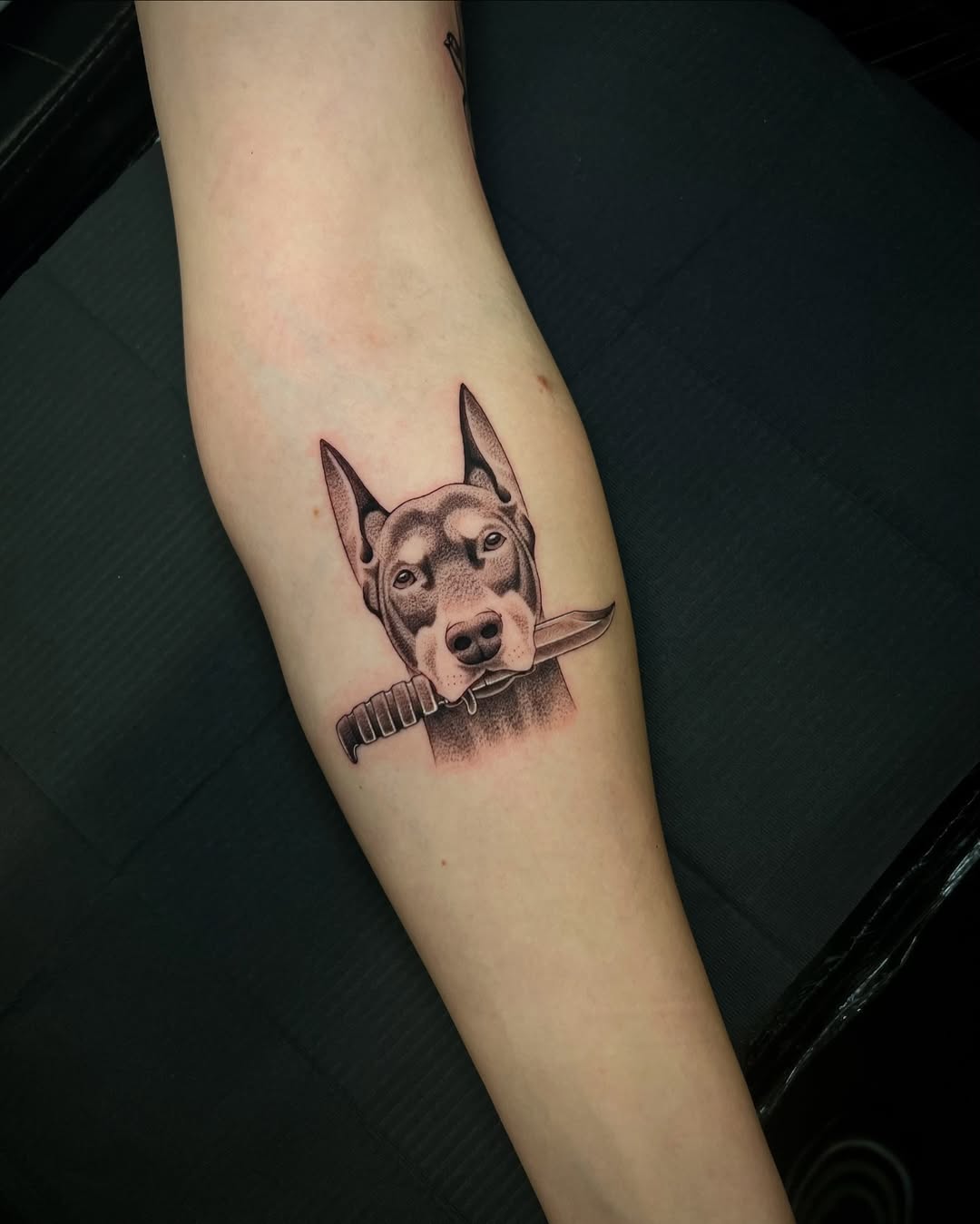
A compact head study holding a short knife between the teeth—protective but composed. Fine stippling gives the muzzle volume; a faint drop shadow grounds the design.
Styling tip: if you like matching tattoos, this motif pairs well with a mirrored version on the opposite forearm—three-inch scale each—to bookend a watch or bracelet.
Soft-Shade Shoulder Study
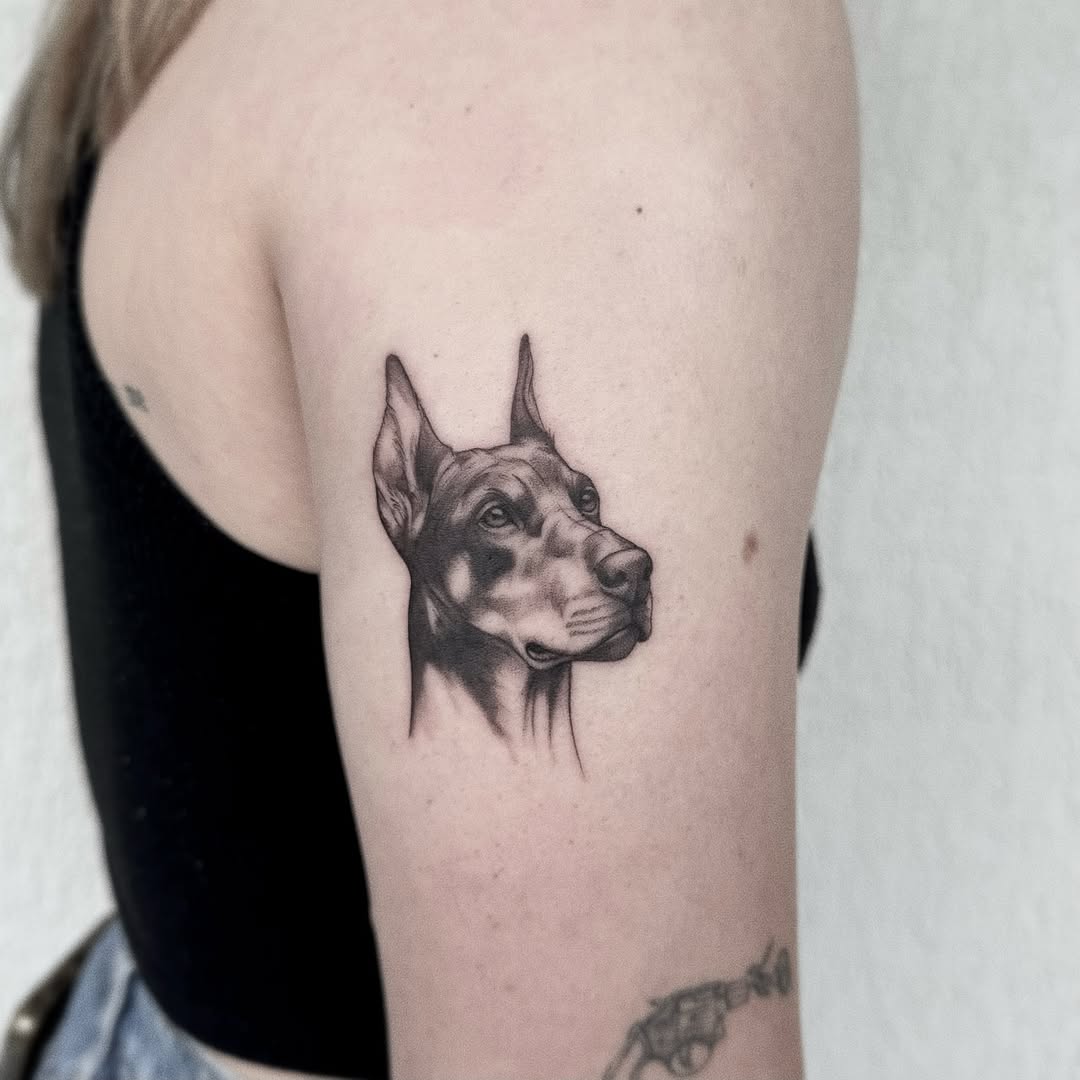
Delicate black-and-gray realism with feathery transitions at the neck and a serene gaze turned slightly upward. No harsh outline—just natural edge contrast—which reads refined and modern.
Styling tip: for those building a set, add a laurel sprig or dates beneath in a tight fine line to honor a companion without crowding the portrait.
Chain-Mouth Portrait on Upper Arm
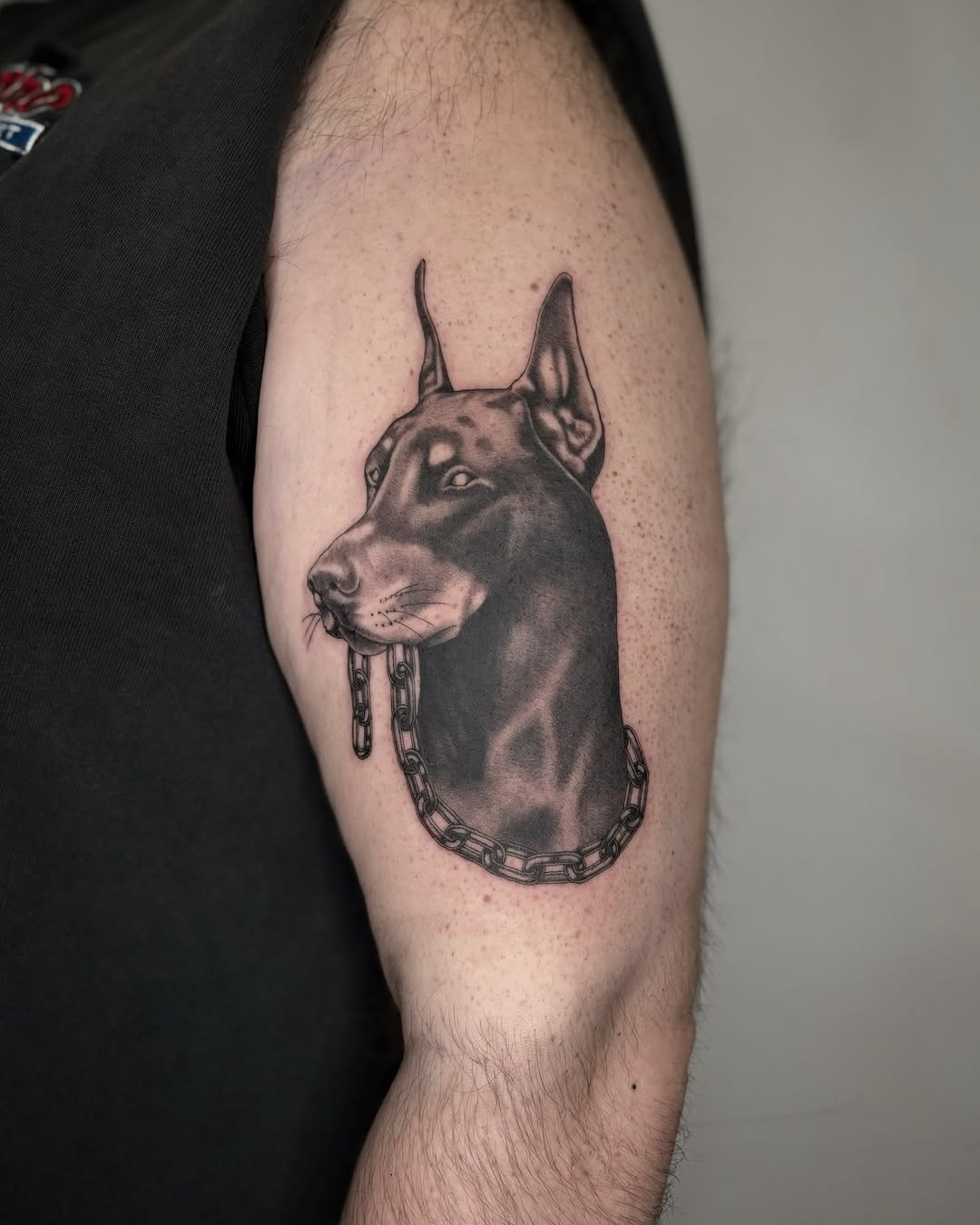
A cool, composed Doberman rendered in soft black-and-gray realism. The head turns slightly off-axis, and a short length of chain slips from the mouth and loops into a heavier collar that circles the neck. Smooth value transitions along the muzzle and brow give the face a velvet sheen; a restrained outline keeps everything crisp without looking heavy. Placed high on the arm, it reads dignified rather than angry—guardian energy, not aggression.
Why it works: the negative space between the jaw and chain adds motion, and the long neck creates a statuesque silhouette that flatters bigger biceps—popular with men who want presence without clutter.
Styling tip: have your artist show the stencil with chain links mapped to the deltoid curve; links that follow muscle flow age cleaner in Doberman tattoos.
Playful Full-Body Realism
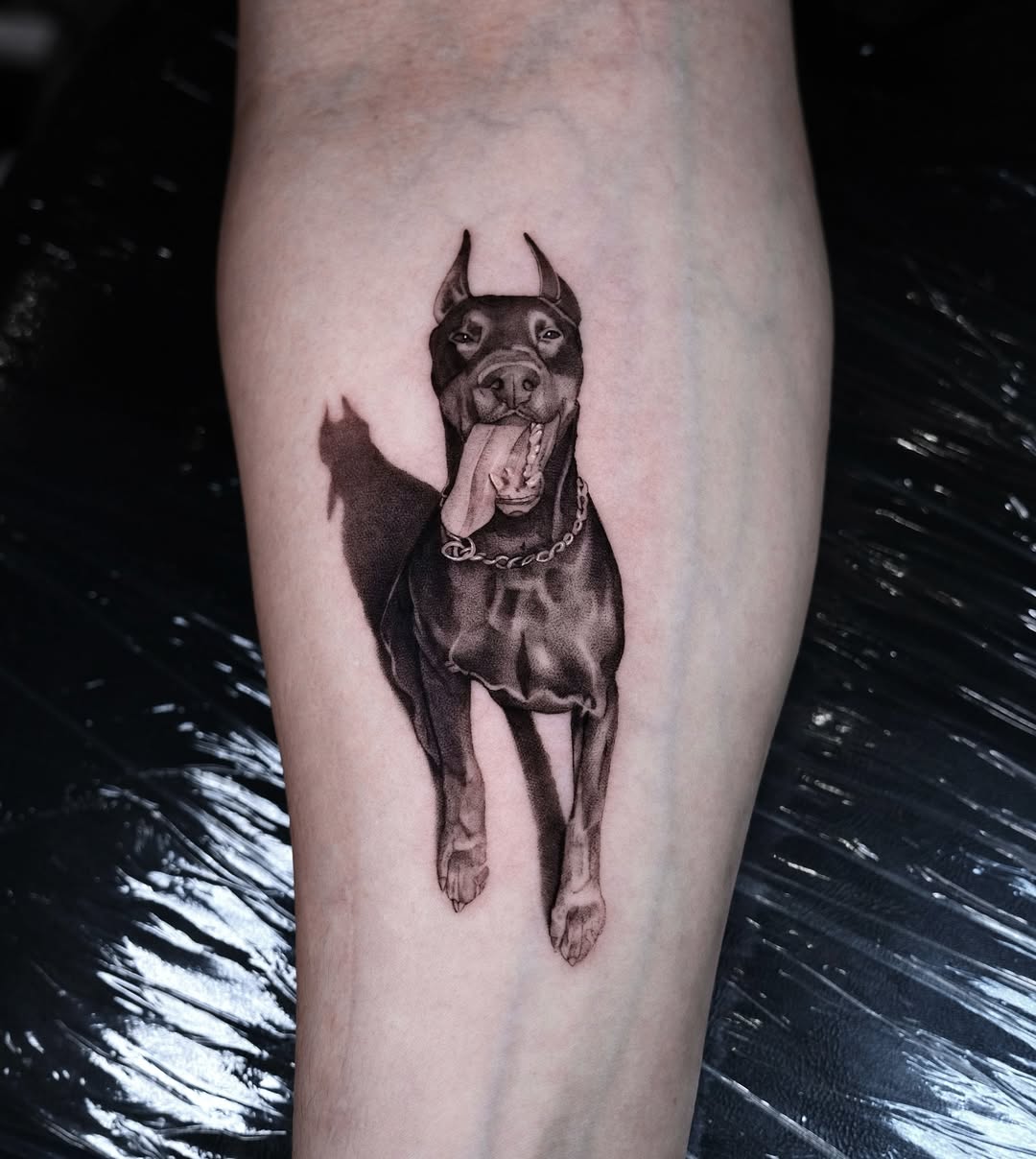
A life-size mini: the dog is mid-stride, tongue lolling, a thin chain draped at the chest. It’s classic realism with a cinematic twist—the cast shadow behind the figure anchors it to the skin and adds depth. Highlights on the nose and eyes keep the expression bright and mischievous.
Why it works: the slim, vertical figure fits neatly on a forearm; from a distance it reads like a candid snapshot. Great for collectors who prefer story over posture.
Styling tip: request a softly diffused base shadow so the piece doesn’t feel “stickered” on; this is a small design detail that makes a big difference.
Graphic Blackwork Head with Spiked Collar
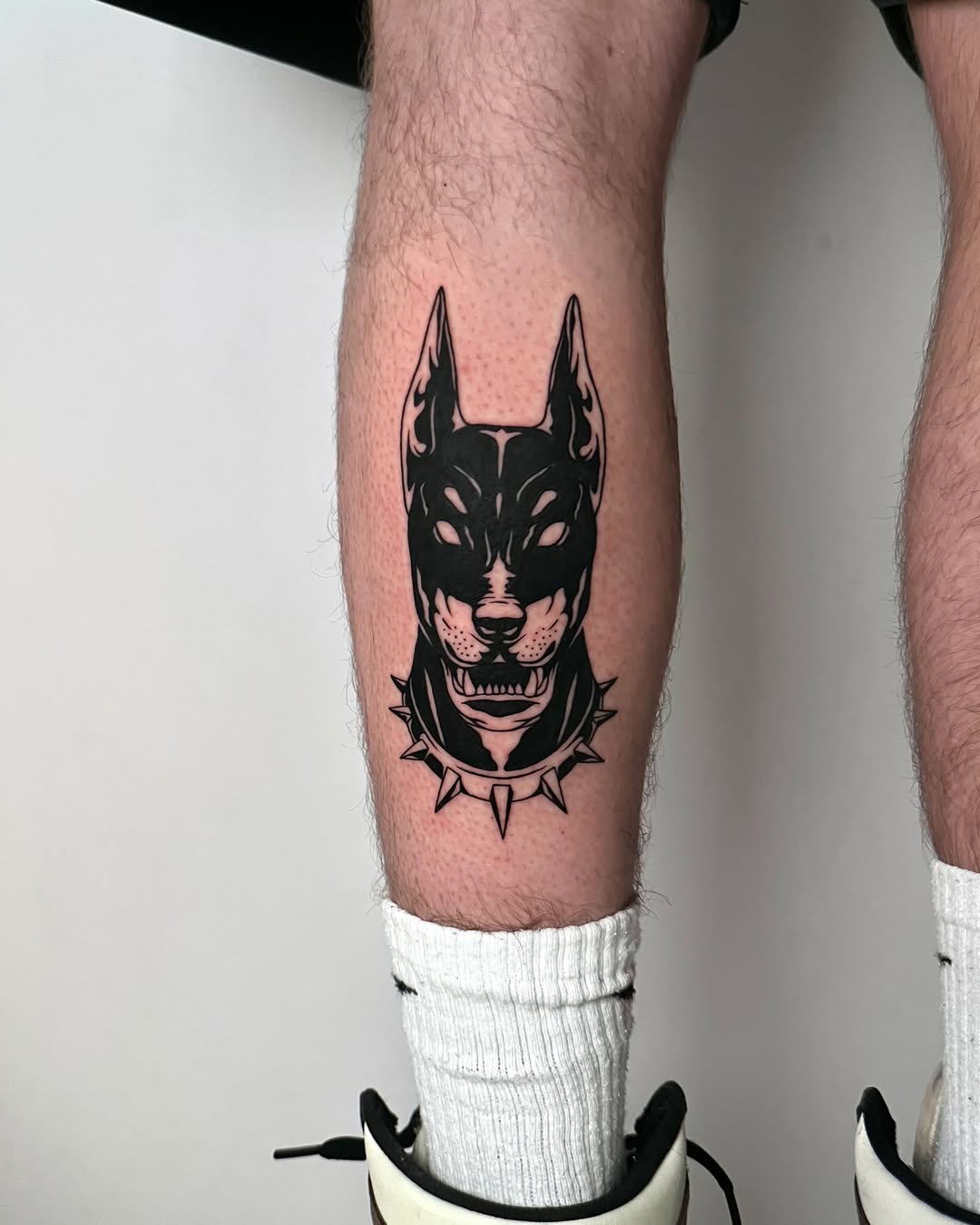
Bold, readable, and unapologetic blackwork. Solid fills carve the ear and cheek planes, while razor-clean outline work shapes the muzzle and spiked collar. White eyes push it into mythic territory—part guard dog, part totem.
Why it works: At walking distance this hits like a logo; it’s perfect for the calf, where straight-on viewing matters.
Styling tip: ask for breathable negative space along the jawline so the blacks don’t merge over time.
Barking Neo-Trad with Hot Red Accents
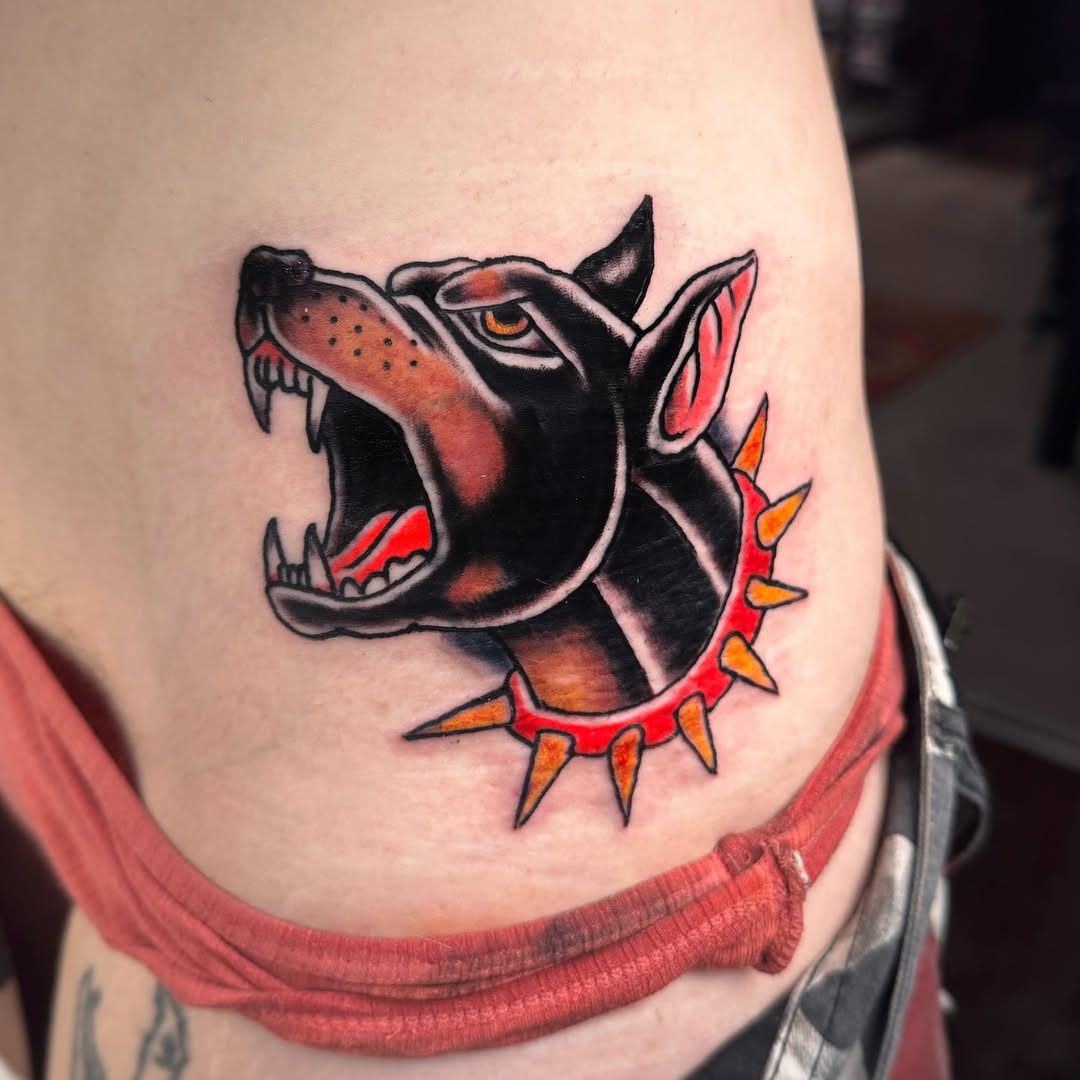
A snarling, barking head in saturated black and ember red. The spiked collar glows, teeth sit in clean negative space, and the inner ear pops in flame tones. It’s a love letter to traditional/American traditional—bold lines, compact shading—tuned for contemporary skin.
Why it works: the compact flash scale makes it versatile for rib, hip, or shoulder placements. The limited palette ensures long-term readability.
Styling tip: keep the background bare—trad designs breathe best against clean skin.
Roaring Shoulder Blade Emblem
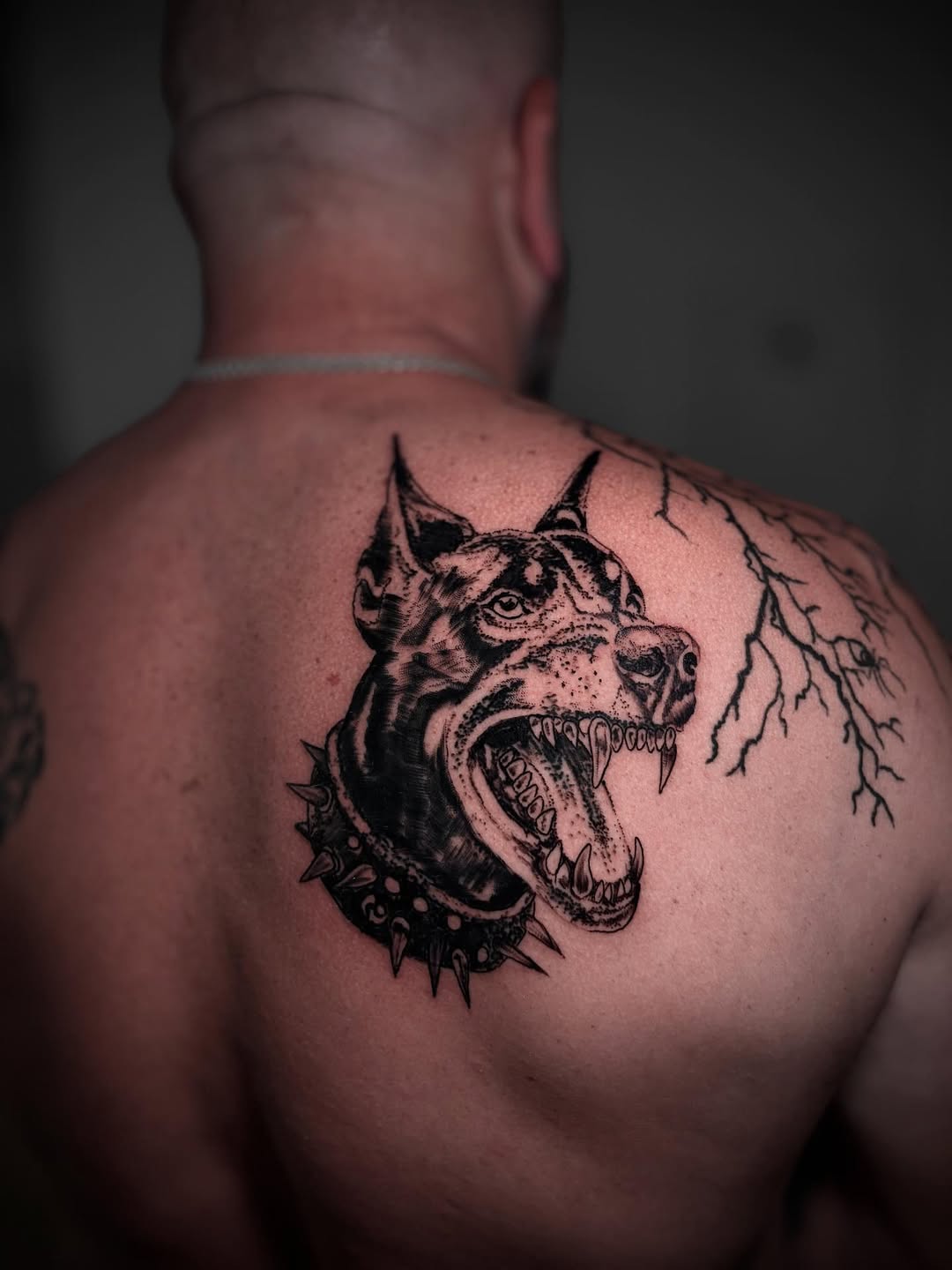
A feral open-mouth portrait with a studded collar—half realistic texturing, half graphic attack. The canine rows are etched with tight stipple; the ear edges burn with dark packing. On the upper back it behaves like armor: a warning sign you can take off your shirt and display.
Why it works: the trapezius gives this motif a natural ramp; the head angle mirrors the shoulder slope, so the composition looks custom-fit.
Styling tip: if you’re building a set, branch lightning or laurel can frame the negative space without stealing focus.
“No Fear” Forearm Story: Crown, Knife, and Cherub
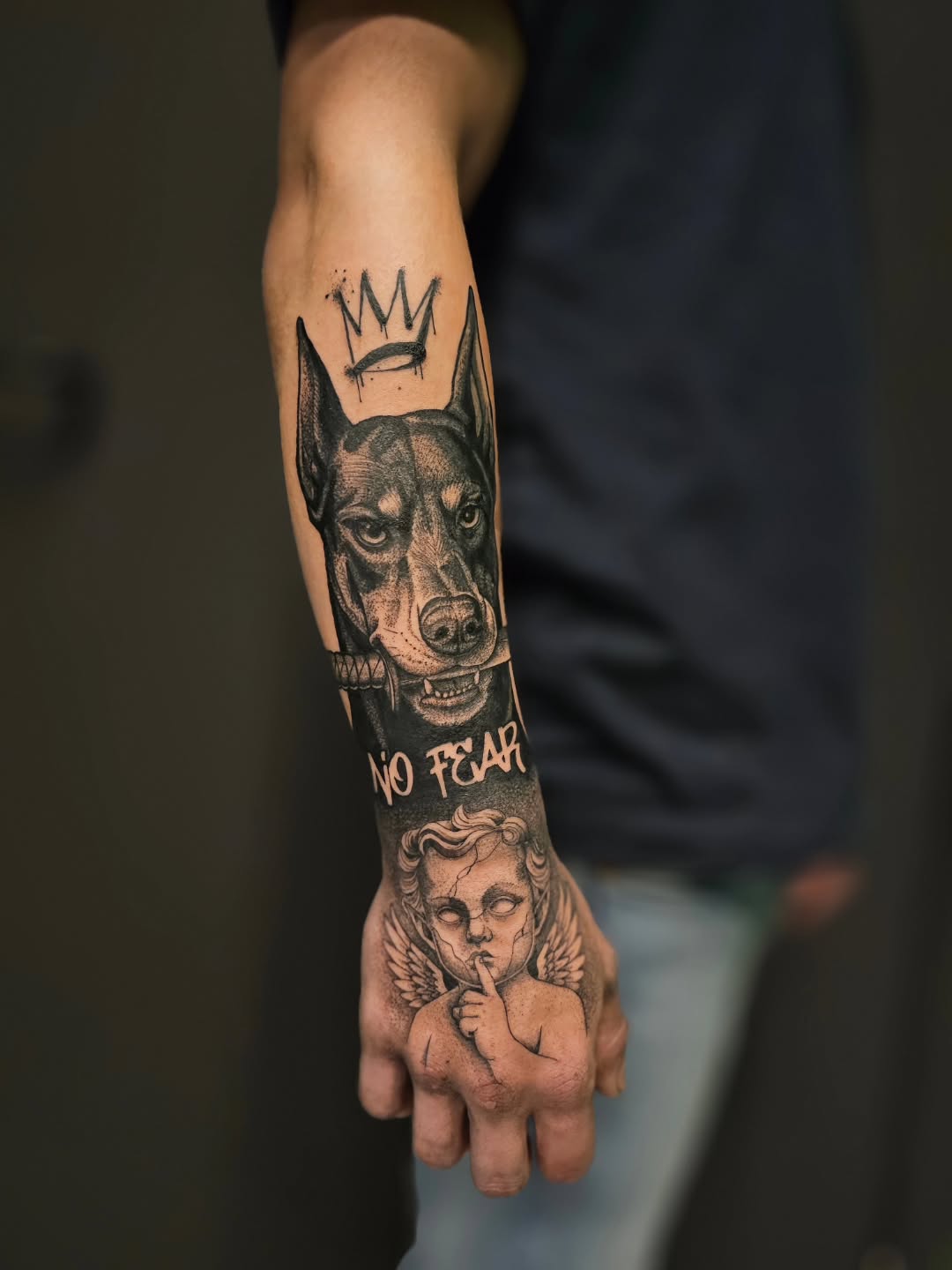
A narrative stack that reads like a sleeve in miniature: a Doberman portrait clutching a knife, a graffiti-style crown floating above, the words “NO FEAR,” and a baroque cherub whispering on the hand. Black-and-gray realism in the dog transitions to illustrative script and classical shading below—contrasts that keep the eye moving.
Why it works: the mix of motifs feels personal, like a diary page—iconic elements arranged for meaning over symmetry.
Styling tip: keep the crown’s fine line and airy so the portrait remains the star; too heavy, and it competes with the eyes.
Soft Dot-Shade Portrait with Starbursts
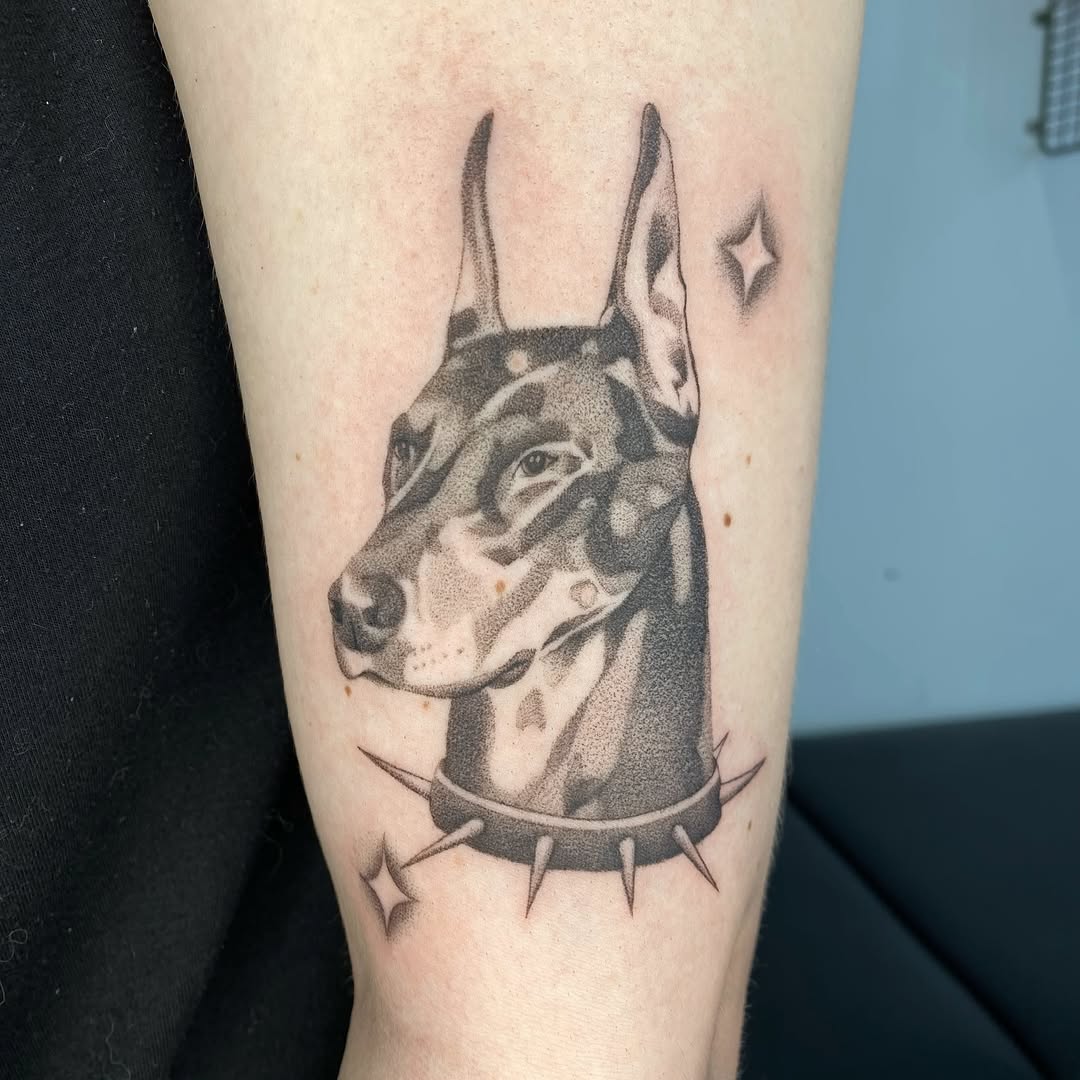
A sweet, small-format head study with gentle stippling and two tiny starbursts for sparkle. The spiked collar is minimal, nearly floating, and the cut of the neck keeps the composition lightweight. Think “micro-realism meets minimalist charm.”
Why it works: approachable for first-timers, yet detailed enough for connoisseurs who appreciate controlled dotwork.
Styling tip: place it where skin is even—outer forearm or calf—so the dots heal evenly. Ask the artist to show a high-contrast stencil to verify spike spacing before inking.
Micro dotwork portrait on the forearm
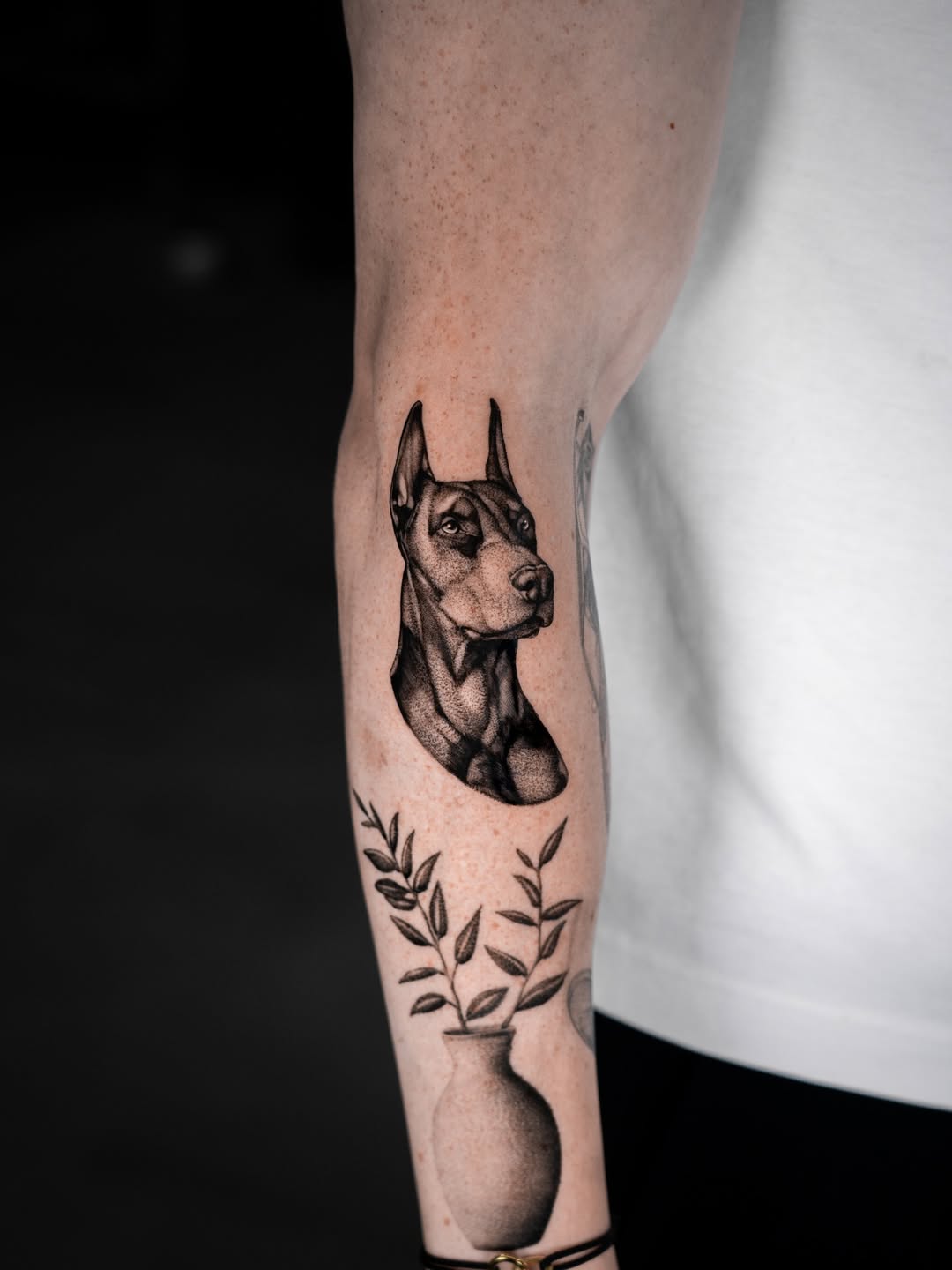
A compact Doberman bust built from tight dotwork and delicate fine-line contouring. The muzzle and brow are modeled with soft stipple gradients, while a whisper-thin outline keeps edges clean without loading the piece with heavy borders. On the arm this reads “minimalist” from a few steps away, but up close it’s rich with texture—an elegant balance of art-school drawing and wearable tattoo craft.
Tip: ask your artist to show the stencil for the ear tips and neck separately; even dot spacing is the secret to long-term clarity.
Atmospheric realism with spiked collar
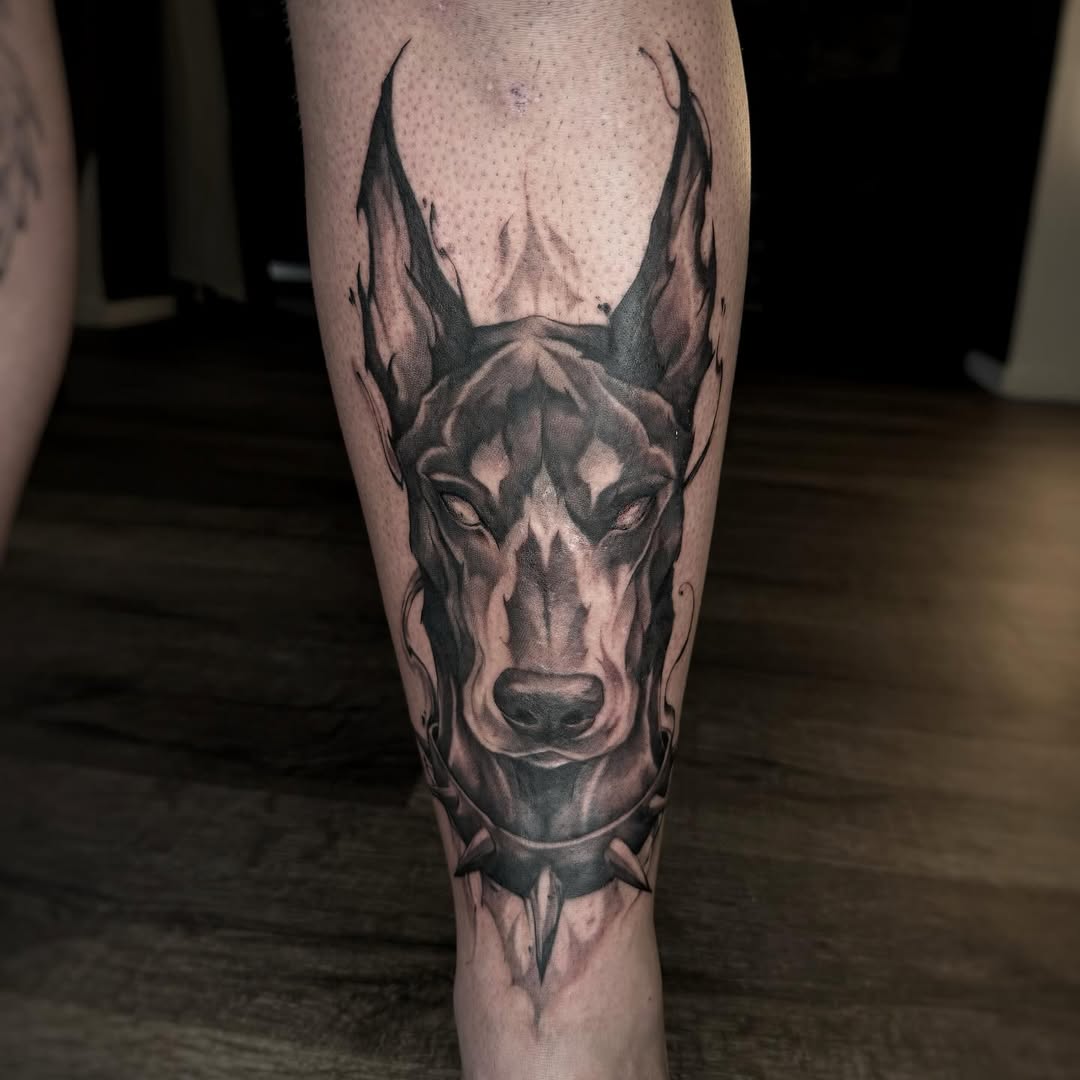
A frontal, full-impact head study wrapped in a spiked collar. Smoke-like shadows lick around the ears, giving the portrait a cinematic aura. It’s classic realism nudging toward blackwork—dense blacks in the ear bases, broad midtones across the forehead, and crisp highlights on the nose. Big presence, zero clutter.
Tip: ensure there are skin borders alongside so the vertical layout gives the illusion of longer legs.
Pocket-size color profile
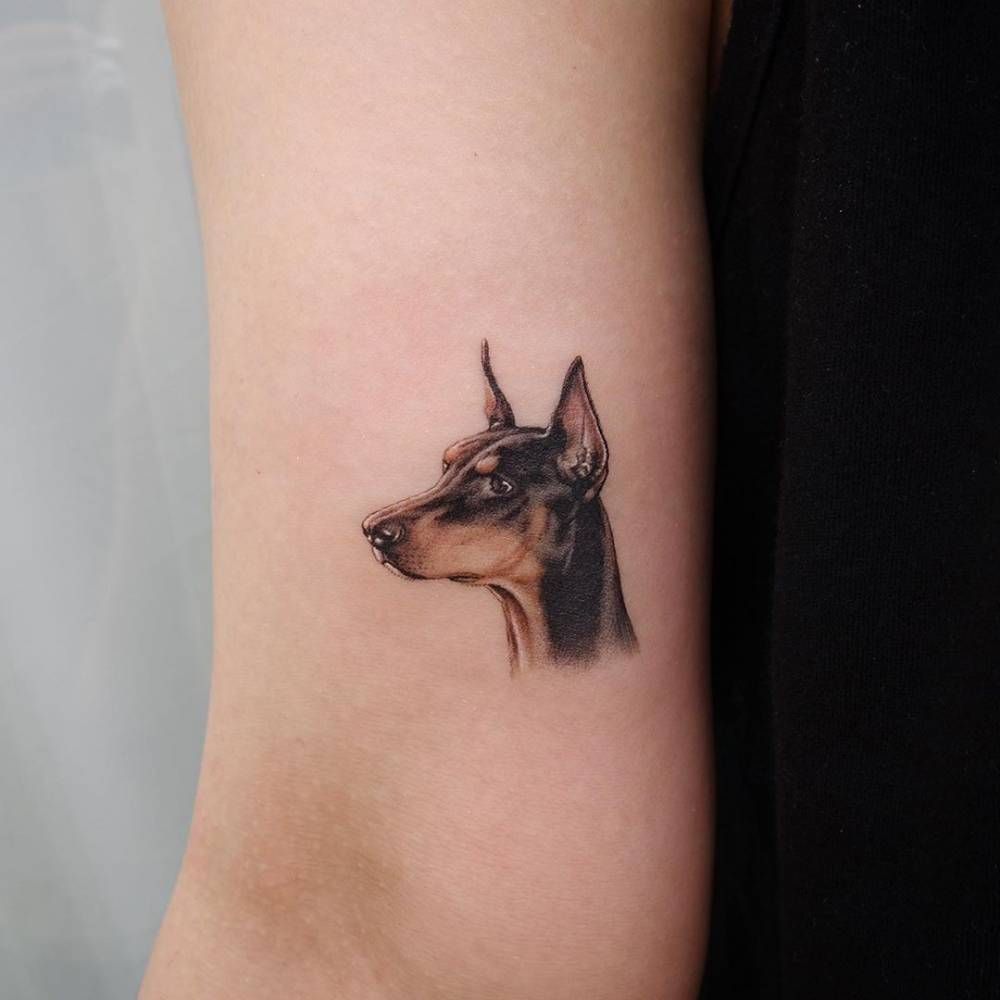
Small color cameo with precise tan points, a highlight of the glassy eye, and a soft fade under the neck. It’s realism at stamp scale—ideal if you want sentiment without shouting. The restrained palette (warm tan, neutral gray, and cool black) keeps it fresh and understated.
Portrait wrapped in barbed wire
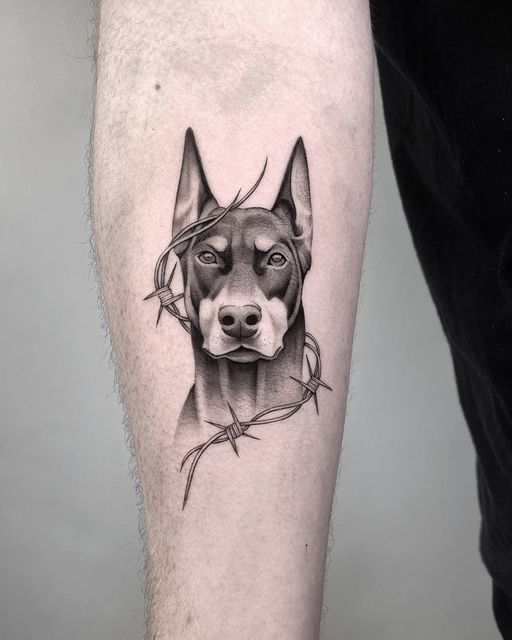
A measured, forward-facing portrait framed by a ring of barbed wire. The wire’s fine line detail contrasts with the smooth tonal build of the face, turning the Doberman into a stoic guardian emblem. Everything feels carefully planned from stencil to final pass—no stray shadows, no guesswork.
Tip: if you’re planning a sleeve, repeat the barbed wire motif as a connective element between future pieces.
Bold outline with spiked collar
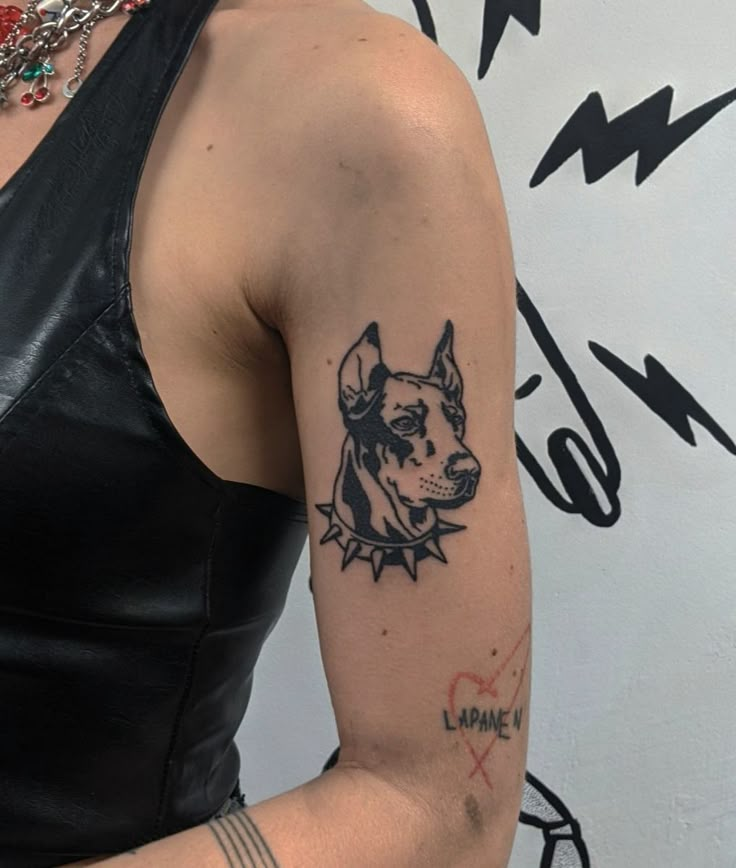
All killer, no filler: thick outline, minimal shading, graphic features, and a classic spiked collar. The vibe lands squarely in traditional/trad territory—clean shapes, readable at a distance, perfect as flash or as the anchor for a larger set.
Tip: a couple of micro transitions on the nose bridge and brow keep it from feeling like a sticker while preserving that bold trad punch.
Calm black-and-gray profile
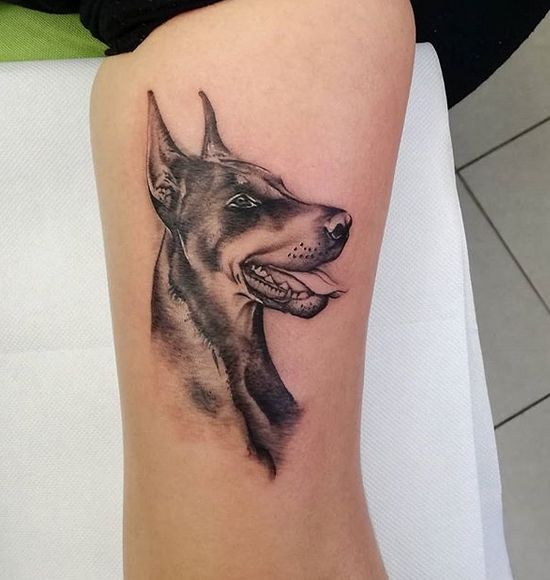
A serene, realistic side view with a gentle breeze of shading behind the neck. The relaxed mouth and visible tongue add motion without slipping into barking or angry territory—this is loyalty and ease, not intimidation. The thigh placement lets the elegant neck length breathe.
Double-exposure “echo head” concept
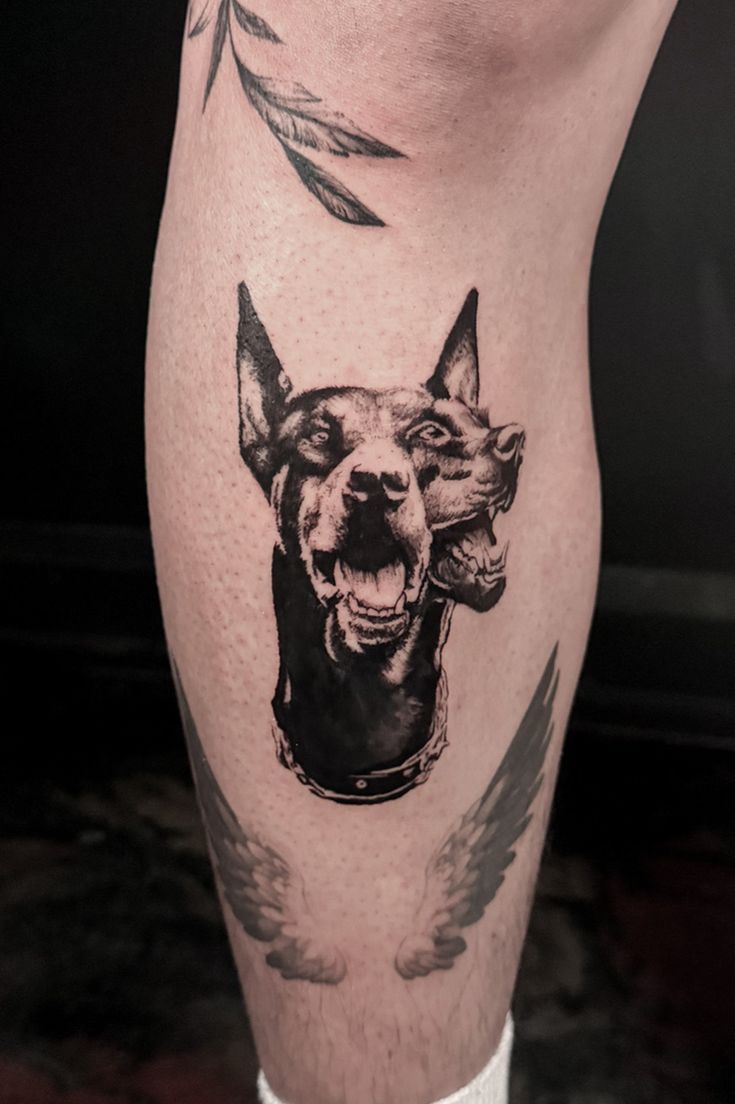
An inventive two-in-one composition: a joyful, forward-facing Doberman sits up front while a second, fiercer profile ghosts behind it—like a filmic double exposure. Executed as dark blackwork realism with bright negative-space teeth and collar glints, it hints at a dual nature: affectionate companion and vigilant protector.
Future idea: scale this up into a three-headed/3-headed Cerberus layout for a back or thigh panel—calm, alert, and angry expressions for a narrative trio.
Every one of these Doberman tattoo ideas proves the same thing: when the design respects the dog’s elegance and nerve, the result never goes out of style. Whether you lean minimalist with fine line and outline work or go full-throttle with blackwork and bold trad shapes, the breed’s posture, ears, and eyes do the heavy lifting—realism just seals the mood. My favorite moment in any studio is when someone pulls out a phone photo of their Dobie and you can feel the room quiet; that’s the energy you want to bottle in your stencil.
If any piece here sparked something—placement, collar style, or a three-headed twist—tell me how you’d personalize it. Drop your questions, stories, or artist recommendations in the comments. I’m happy to help you fine-tune a concept or review a draft before you book.
